What's the best tide to catch speckled trout? The beginning or end? Rising or falling? This blog post reveals the key knowledge most anglers are missing.
More...
The Truth About Speckled Trout And Tides
If you spend a lot of time browsing fishing reports then surely you've seen this age old question:
What is the best tide to catch speckled trout?
And we often see this generic answer:
Just before and after tide change.
There's always some "expert" wielding that typical (and not so well thought out) answer that is usually accompanied by a tide table with arrows pointing to the exact times you need to be casting a line, like this one:
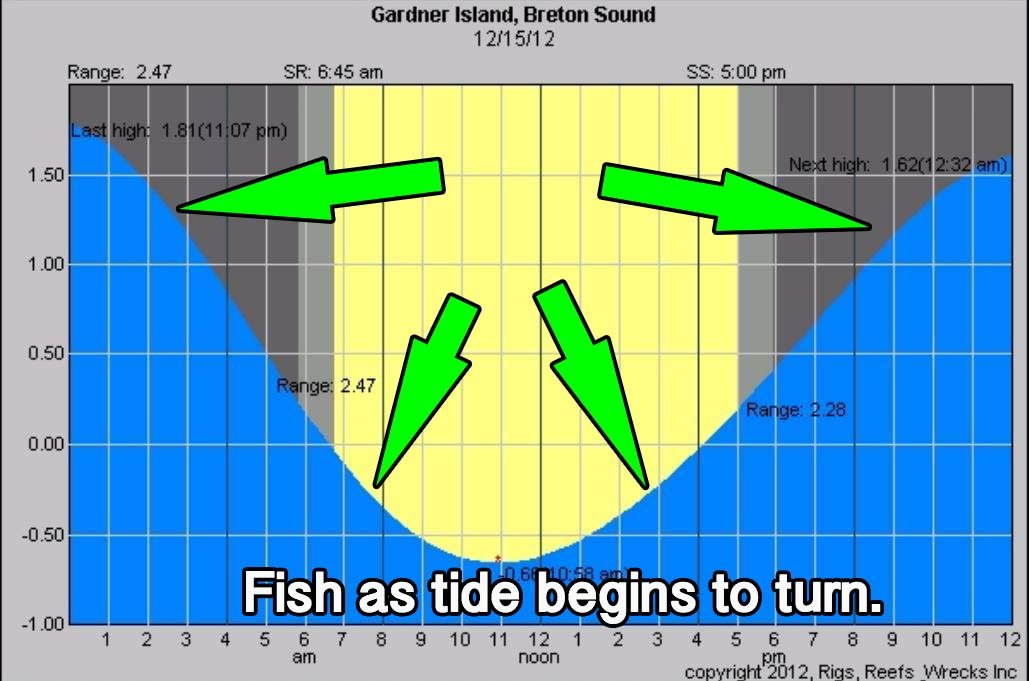
The above graphic isn’t totally right, nor is it totally wrong. It’s just not as right as it could be.
Let's call this piece of advice the "recommended tide time" advice and –I'm going to be a straight shooter here– that specific piece of fishing advice could not be more wrong.
Yes, that seems harsh but, trust me, keep reading and you'll understand where I'm coming from.
The problem with the above graphic is that the information it portrays is very one-dimensional: it only tells you what the tide is doing at one location with all things being equal.
But we're not fishing at one location, and things are never equal in the diverse environment of inshore fishing.
If you look back at that graphic you'll see the supposed (and not actual) "best tide to catch speckled trout" occurs at roughly 7:30am and again at 2:30pm (give or take).
Well, I promise you that fishing only at 7:30am or 2:30pm is a great way to make sure you don’t catch a limit of speckled trout.
The reality is that the best tide to catch speckled trout is not happening only during those times.
Whatever is practically moving all day long and – if you use what's in the rest of this blog post – you will be able to consistently locate that moving water.
This is because water flows differently through each uniquely shaped body of water in the marsh.
I don't want to get ahead of ourselves here, and think it's best we take it from the top to ensure we're both on the same sheet of music.
So, to fully understand the concepts I'll explain in this blog post, lets look at:
Why do speckled trout love moving water?
Because it is easier for them to feed.
Generally speaking, rather than burn energy chasing bait, they let the tide bring the bait to them.
Knowing this, speckled trout can be found waiting in spots where bait is flowing, like shrimp during the fall migration.
In fact, it looks exactly like this:
Pretty cool video, right?
It’s easy to see this simple concept: if water is moving, trout are active and more likely to be feeding.
When the water is slack, they become inactive and hardly feed.
KNOWLEDGE BOMB
It's worth noting that speckled trout do not always use the tide to feed like what you see, though they generally do.
During winter conditions they are found feeding on finfish not found in the current.
This blog post explains why in detail.
Okay, now we know how they feed, so what is the best tide to catch speckled trout?
The trout in the video do not know exact details like tidal range, when there will be low tide, high tide or the price of tea in China.
They’re just fish with tiny brains.
(sometimes outwitting humans with much larger brains)
All they know is that the water is moving and bait is coming to them, so they are ready and looking for food to eat.
Water movement is what matters.
NOT specific times on a tide table.
So, the question we should really be asking is:
What kind of water movement is best to catch speckled trout?
The answer is plain as day in that video.
You’ll see it is not too slow and not too fast (not that there is an exact current speed you can measure to discern if biting trout are present or not, we are just going with the working assumption that extremes aren't ideal).
Now you should ask:
Q: Where can I find that kind of water movement like what I saw in the video?
A: You can find that kind of water movement at virtually any time, somewhere in the marsh.
This is because bodies of water are not shaped the same (as mentioned earlier) and – because they are not shaped the same – water will flow differently through them.
In order to shed some light on this concept I must teach you two things to answer this question (and show you where biting speckled trout can be found).
It's Time To Learn Fluid Dynamics
Okay, I know I just whipped out some science on you, but don't tuck tail and run just yet.
“Fluid dynamics” is nothing more than a fancy ten-dollar word that means “how water moves”.
I’m not referring to gravitational pull of the sun and moon, or water levels affected by wind.
I am referring to how water flows through a space or – in our case – a lagoon, bayou, trenasse, bay, etc.
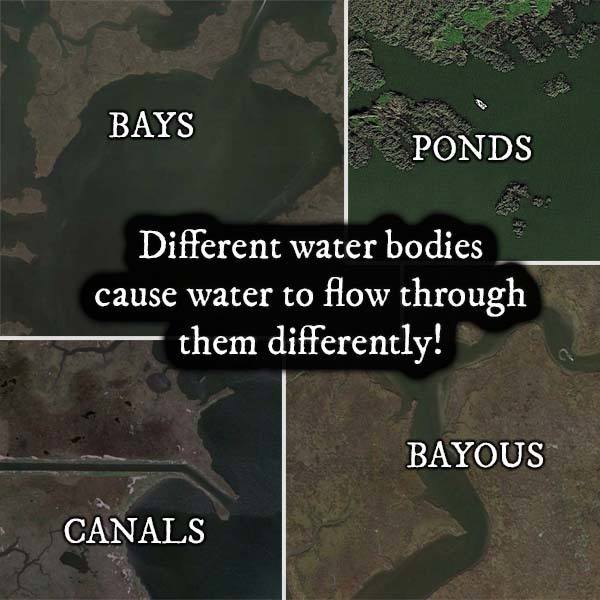
Flow Velocity
Flow velocity really means “current” or “water speed”.
Faster flow velocity = faster water current.
Water will flow faster through a smaller space, and will flow slower through a larger space.
Flow Capacity
Flow capacity refers to how much water is flowing.
The bathroom faucet does not have as much flow capacity as the Mississippi River.
Only a larger space can accommodate more flow capacity.
Confused? Try This:
Try this breathing exercise if you're having a tough time understanding these concepts. Crumple up a small piece of paper and place it on a table in front of you.
Now, open your mouth as wide as you can and try blowing the paper off the table. It's difficult isn't it?
This time, close your mouth and pucker your lips to blow the paper off the table (like you normally would). It worked, didn't it?
When your mouth was wide open you couldn't get your breath to come out fast enough to blow the wad of paper away. It wasn't going fast enough. Your breath didn't have much flow velocity.
But, when you formed a small space to push your breath through, you were suddenly able to create enough flow velocity to achieve your goal.
This same principle applies in the marsh.
What do fluid dynamics have to do with the best tide to catch speckled trout?
Understanding these two concepts makes it easier to see that water movement will vary across nearby locations despite having the same amount of solar and lunar gravitational pull on them.
For example, water flows faster through Bayou Maringouin than it does across Bay Chicot.
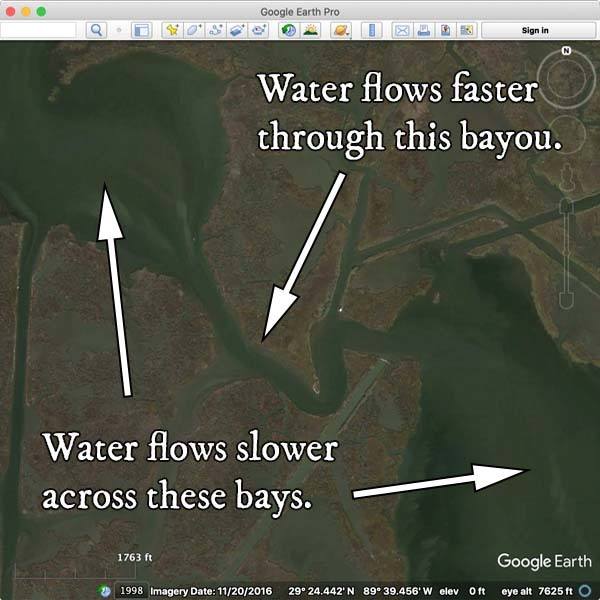
So, looking at the graphic below, if you observe slack water at Spot X in Bay Chicot, then a move to Spot Z in Bayou Maringouin may yield moving water and biting trout.
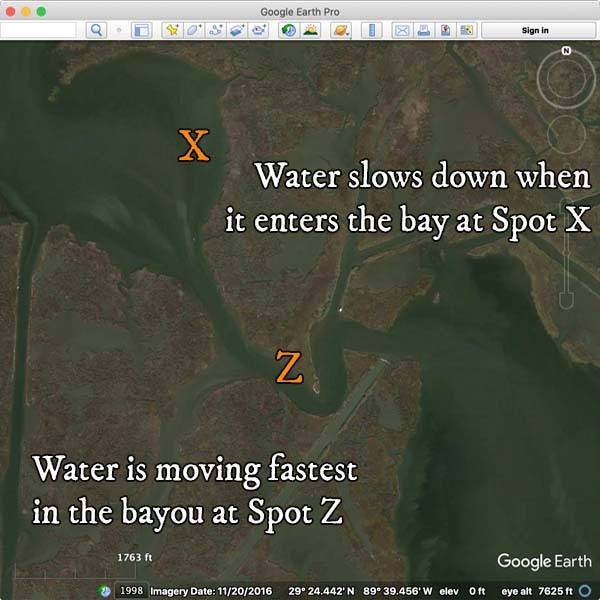
Or, if water is moving too fast at Spot Z, then a move to Spot X may be the right decision.
There's something to this concept, because there's a boat fishing the mouth of Bayou Maringouin!
This is crazy considering this spot was picked out purely for how it looked on Google Earth.
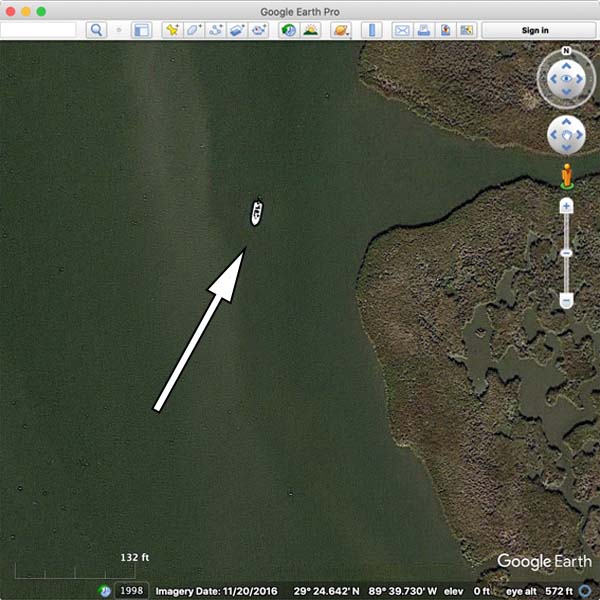
Putting It All Together To Understand Moving Water And Speckled Trout
Now do you see the genius in truly understanding the best tide for speckled trout?
It doesn't matter if you are not at Spot X during the so-called "recommended" time.
You did not miss the trout bite simply because you can make a small move to find the right kind of moving water and get back on them.
On the flip side, you could arrive at Spot X for the "recommended" time of 7:30am just to discover that water isn't moving as it should.
What are you going to do? Fish there anyway because that's the "best time" to fish for speckled trout?
That'd be a very poor fishing decision and outright ignoring the conditions at hand.
These Fishing Locations Also Share This Characteristic
The example we just went through is a good one, but not the only one.
These are other fishing spots you should be looking at:
Now do you see that the "recommended tide time" advice is poor fishing advice?
That ding-a-ling tide table cannot possibly predict the kind of moving water speckled trout like to feed in.
Now, let's cover one more important concept to better understand the best tide to catch speckled trout.
Use Multiple Tide Tables On Your Fishing Trip To Get The Most Moving Water Possible
Remember that at the beginning of this blog post I had mentioned that a tide table only gives you tidal information for a single fishing spot.
Well, good thing we fish in more than one fishing spot!
Fact of the matter is that tidal highs and lows are spread out across space and time, sometimes with a big difference between two areas that are relatively close to each other.
The best example of this tidal phenomenon would be the Biloxi Marsh (Biloxi State Wildlife Management Area on the map below) near Hopedale, Louisiana.
It's wedged between two major tidal juggernauts, Lake Borgne and Breton Sound, and in the graphic below they are represented by the Shell Beach and Comfort Island tide tables, respectively.
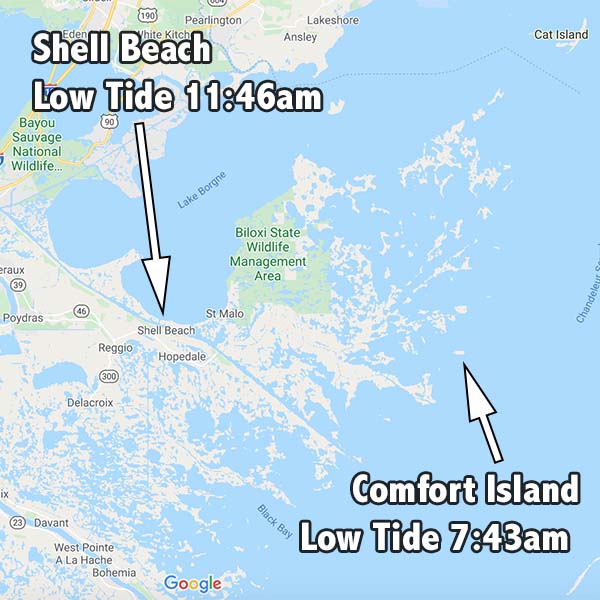
As you can see, these two tide tables (on this one specific day) are four hours apart.
This means that – when you run out of falling tide at Comfort Island – you can make a move to Shell Beach to begin fishing a falling tide once again.
No, it's not time travel.
You're just taking advantage of the fact that the distance between the two tide tables is (only) 25 miles and there's four hours difference between them.
Don't you think it's possible to cross 25 miles in less than four hours?
Exactly.
Of course, you don't have to go all the way to Shell Beach ( or vice versa, like I did in this fishing trip to that location)
In my experience, you just need to get closer and pay attention to indicators of moving water as you make your run.
The all-time favorite are crab traps!
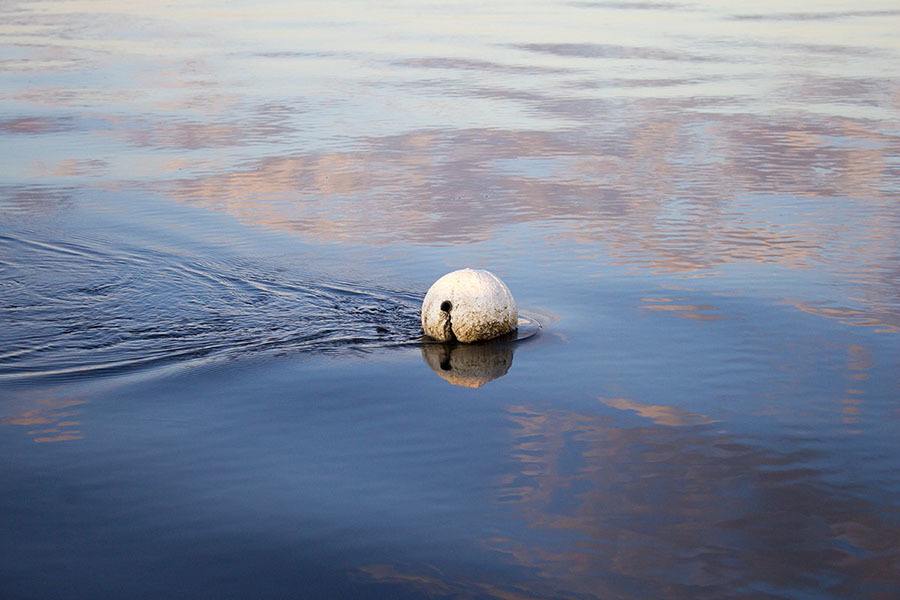
Crab traps are a great indicator of which way and how hard the water is flowing at a given spot.
Lake Borgne and Breton Sound aren't the only example.
Manila Village and Pass Abel are on opposite sides of Barataria Bay and have a big difference between tidal lows and highs, as much as 7 hours!
See how understanding all this is a much better answer to the original question of "what is the best tide to catch speckled trout"?
What do we do when there's a neap tide?
This is a good question, because speckled trout tend to feed less during a neap tide.
Up until this point we've been operating on the assumption that there is some kind of a tide range to work with.
But what if there's little to no tide range at all?
You can still successfully apply the knowledge here to find where there will be at least some kind of moving water.
The types of fishing spots listed earlier in this article are good examples, especially big points in large bodies of water.
Good examples include the south end of the Trestles in Lake Pontchartrain and the end of the Long Rocks in Hopedale (though that's a rock jetty, not a big point).
Conclusion About Speckled Trout And Tides
The "recommended tide time" answer is a poor one, and that's because it doesn't acknowledge how dynamic the marsh is.
So, in the future, when someone asks "What's the best tide to catch speckled trout?" you will know that the only answer you can give must include these two facts:
- Current speed changes with the size of the water body.
- The tide does not move uniformly across the marsh.
When you understand those things, you are apt to make better decisions on the water that lead to catching more fish which ultimately ends up making great memories that last a lifetime.
Isn't that what we are all after?
Moving Water Is Only One Piece Of The Puzzle
What we covered in this blog post is only one piece of inshore fishing knowledge that I use to consistently catch limits of speckled trout and redfish.
There are many other things I can share with you:
These are things I share in my weekly newsletter and, if you'd like to get them, all you have to do is sign up!

Thank you, Thomas!
Good info
Give it a try! Be sure to check fishing reports in LAFB Inshore as well. Tight lines and thanks for reading!
I live in Biloxi, MS. I do alot of fishing and I have caught some black drum, white trout and red’s but I have never hooked any speckled or spotted trout . I don’t know what I doing wrong but thanks for the tip and I will try that.
Ordinarily I would but it didn’t go so well. Seems sheepshead was the only thing biting today
Be sure to let us know how you do inside LAFB Inshore: http://bit.ly/2XbmWOK
Thanks for commenting!
Very informative post. I’ll try to remember all of this when I go fishing in a couple of days.
Gary, I never received such a question.
I appreciate you asking, but it’s impossible for me to fish everywhere along Louisiana’s coast enough to know what’s going on everywhere.
This is why I created the LAFB Elite Community and why I recommend you check there for fishing reports:
Thanks, Gary.
i sent you a question about 2 weeks ago concerning the Vermilion Bay fishing reports. Did you not recieve it or is it that you haven’t heard anything from that area
Why not fish the entire water column? That’s what is taught inside Elements of Effective Fishing and it works quite well.
If you dropped your leader to the bottom and didn’t catch anything, what’s keeping you from fishing the top, or the middle? Would you just leave or try the rest of the water column?
Ok you covered flow, yet what about depth? How do I know where to drop my leader?
Hey Charles, thanks for commenting!
Honestly, the whole point of this guide is to put less stock into the exact timing of the tide and more into how water flows.
That way you can stay on top of moving water and (ideally) biting fish.
Think about this: what if you got to Bay Round and there was no tidal movement? I hope you would use what’s in this guide.
But it’s also worth noting that the wind is a factor here, and that will also affect the timing of your tide. This guide covers that more in detail: https://www.lafishblog.com/how-to-fish-tides-in-louisiana/
Despite the warm weather it is still the spring pattern, for which there is a guide here: https://www.lafishblog.com/speckled-trout-spring-pattern/
Thanks, Charles!
I enjoyed VERY MUCH reading your advice. I normally fish the Myrtle Grove area (Bay Round, Bay Laurier, etc). I normally come home with dinner and Xtra fish for friends. I have just recently converted to plastic. Having said that my questions are as follows:
What is the approximate time difference in posted Manilla Village tides and Bay round?
Given the early heat is summer fishing pattern already here?
Thanks again.
Glad you liked it! Consider subscribing if you’d like to see more in the future: https://www.lafishblog.com/subscribe/
Very much in joyed the the read and the video. Thanks for sharing!
Cecil
Roger that, glad I wasn’t going nuts. Your point is a key one regardless…….don’t end the day just because the tide quit on you when a move of reasonable duration/length could put you back on feeding fish because tide isn’t done elsewhere.
You aren’t missing anything! The times in the graphic are correct, but flipped in the text. They have been fixed.
I wonder how many people have seen the wrong times and didn’t catch it? Good eye, Darren, and thanks for pointing it out.
And please, comment any time.
Tight lines!
Enjoyed the article, as always. Had a question regarding the following note, however:
“As you can see, these two tide tables (on this one specific day) are four hours apart.
This means that – when you run out of falling tide in Shell Beach – you can make a move to Comfort Island to begin fishing a falling tide once again.”
Because the tide is at dead low at Comfort Island (7:43a) 4 hours before it is at dead low at Shell Beach (11:36a) I would have thought the statement above would be the opposite. In other words, you’re out at Comfort and it’s gone slack (dead) at about 7:30 am, early in your trip, but it doesn’t reach that same condition for another four hours inside at Shell Beach……head in and find water still moving. On the flip side, you’d start seeing it RISING out at comfort sooner than inside at SB as it turns around following the 7:43a low. So if you were in fact fishing inside at SB and tide went dead low on you at 11:36a, you could expect to run out to Comfort and find the beginning of a rising tide in motion.
Am I missing something ?
In summer, the tide is often rising in the mornings. In my experience, it peaks out in the Sound early but on our way back to camp in SB, it’s not unusual to find crab trap buoys strung out as the high is yet to come in Shell Beach.
Tight lines, enjoy the discussions on here.
I have fished Comfort Island a LOT. Why do you ask?
I’ve posted reports for that island and area in general on LAFB Inshore and the LAFB Elite Community.
Do you fish comfort island much?
Yes, and thank you for reading.
Thanks for reading, John. Be sure to subscribe to my newsletter if you’d like more.
Tight lines!
Great article, I learned a lot. Trout feeding video was awesome! Thanks
Great advice this often in Reggio and Delacroix
Steve, you’re too kind. lol
Thanks for reading!
Hey Captain Pat, thanks for taking the time to comment.
You’re 100% correct. It can be an all day ordeal moving from spot to spot trying to find a good bite.
A lot of folks don’t realize that, so it’s good to have you comment here so they see it.
Tight lines!
I’m glad you liked it and thankful you read the whole thing, it’s not a short read!
Tight lines.
Mind Blown. By the time I finished reading the article I suddenly view my body of water differently and realize I have made mistakes. Can’t wait to go fix them😊
I enjoy reading your blog and recommend it to my clients. It makes my job easier when clients understand why we often need to make several moves to get on fish bites.
great post Skipper I really learn something new every time I open an article you write. keep em coming
thanks